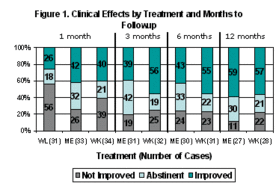Treatment for pathological gambling often receives minimal insurance coverage. For example, a recent survey in Massachusetts revealed that about 39% of individuals who contacted Massachusetts Public Health funded treatment centers did not pay with insurance either because they did not have insurance or because they did not have adequate coverage for gambling treatment (Shaffer, Gallery, LaBrie, Scanlan, & Milisci, 2002). The need for inexpensive, yet effective treatment options, then, is high. In this issue, the WAGER reviews a recent study by Hodgins, Currie, and el-Guebaly (2001) that examined a minimally invasive and low-cost problem-gambling treatment strategy: self-help workbooks. The outline below summarizes the goals and tasks included in the self-help workbook reviewed by Hodgins, Currie, & el-Guebaly (2001).
Self-assessment
- focus on increasing awareness of consequences and triggers of gambling
- SOGS
- checklist of negative consequences
- calendar to identify financial costs over time
- identify situation, affect, and cognition for past 3 gambling occasions
- checklist of reasons for gambling
Goal Setting
- decision balance exercise derived from Janis & Mann (1977)
- discussion of abstinence or controlled gambling as a goal
- specification of personal goal
Strategies
- Review: cognitive restructuring, cognitive or behavioral coping, stimulus control, and creating social support networks
Maintenance
- goal: coping skills for relapse prevention
- review previous sections
- identify other life problems
Other resources
- information on accessing other resources
Hodgins et al. (2001) provided an empirical examination of the effectiveness of this workbook by comparing the 1-month, 3-month, 6-month, and 12-month gambling behavior of pathological gamblers randomly assigned to one of three groups:
(1) self-help workbook alone (WK), (2) self-help workbook plus a motivational enhancement (ME) phone interview, and (3) wait list (WL). The authors measured days gambled, dollars lost, and dollars gambled per day to assess the clinical effects of intervention. Follow-up data for wait list participants was only available at one month. Results indicated that all groups showed improvement over pre-treatment assessment at one month. Interestingly, although still improved over pre-treatment assessment, the self-help group and self-help plus ME group were never significantly different from each other at three, six, or twelve months (see Figure 1). However, these results indicated that after one month most individuals improved their gambling behavior; no more than ¼ of the participants (workbook alone at three months) failed to improve at any later follow-up.
These results are promising and suggest that low-cost treatments might be viable alternatives to more intensive programs. However, more research is needed. First, the study used a relatively small sample. Research utilizing a larger sample will determine the stability of this pattern of results. Second, this study did not use a proper control group. The wait list group was not adequate because these individuals were treatment seekers who expressed interest in reducing their gambling behavior. The authors expressed surprise at the observed improvements by wait list participants, but the participants’ desire to cut down their gambling likely contributed to a motivated natural recovery process. It is uncertain if this process occurred in the treatment groups as well, but nonspecific treatment effects are quite common. Third, the follow-up interviews conducted at one, three, six, and twelve months likely influenced the outcome of the study. More research is needed to determine whether these favorable results remain with less frequent contact. Finally, this research did not include a ME alone modality. Without an estimate of the effectiveness of ME by itself, the benefit of including the self-help workbook in a combined treatment cannot be established. The most cost effective treatment might be ME by itself or, the slightly more expensive, ME plus the self-help workbook.
Given the limited number of treatment outcome studies, Hodgins et al. (2001) have contributed to the treatment outcome literature. It is striking that this minimal intervention—whatever the causal elements were—improved the gambling behavior of all but about 16% of participants. This intervention had minor financial, social, and time costs. Other treatments (e.g. Griffiths, Bellringer, Farrell-Roberts, & Freestone, 2001) require constant contact for close to a year and are much more costly. More research should pursue more cost-effective strategies.
References
Griffiths, M., Bellringer, P., Farrell-Roberts, K., & Freestone, F. (2001). Treating problem gamblers: A residential therapy approach. Journal of Gambling Studies, 17(2), 161-169.
Hodgins, D. C., Currie, S. R., & el-Guebaly, N. (2001). Motivational enhancement and self-help treatments for problem gambling. Journal of Consulting and Clinical Psychology, 69(1), 50-57.
Shaffer, H. J., Gallery, B., LaBrie, R., Scanlan, K. M., & Milisci, P. (2002). Pathological gambling treatment and insurance coverage: A first glimpse from Massachusetts’ treatment programs. Boston, MA: Harvard Medical School.





